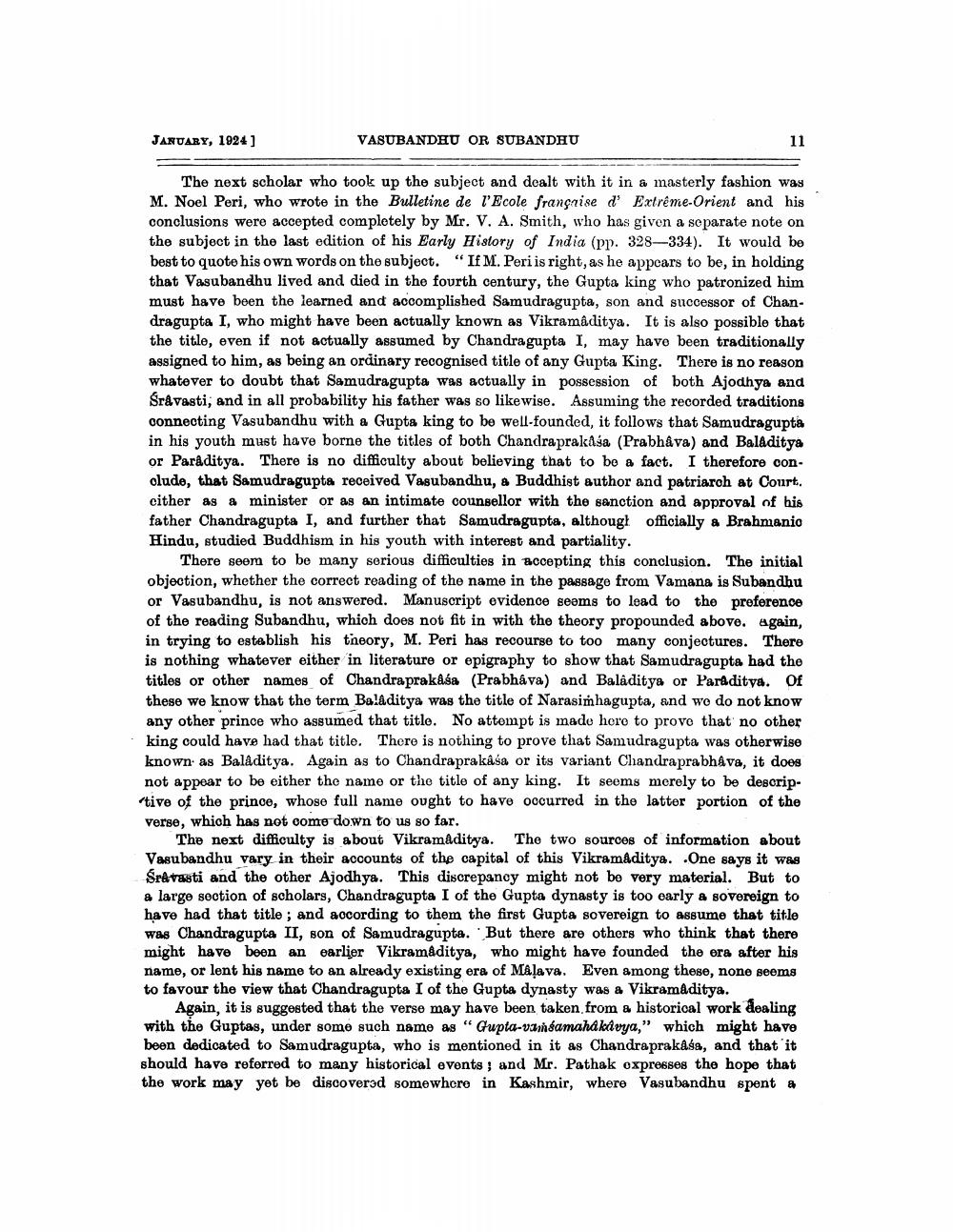________________
JANUARY, 1924 ]
VASUBANDHU OR SUBANDHU
11
The next scholar who took up the subject and dealt with it in a masterly fashion was M. Noel Peri, who wrote in the Bulletine de l'Ecole française d'Extrême-Orient and his conclusions were accepted completely by Mr. V. A. Smith, who has given a separate note on the subject in the last edition of his Early History of India (pp. 328-334). It would be best to quote his own words on the subject. "If M. Peri is right, as he appears to be, in holding that Vasubandhu lived and died in the fourth century, the Gupta king who patronized him must have been the learned and accomplished Samudragupta, son and successor of Chandragupta I, who might have been actually known as Vikramaditya. It is also possible that the title, even if not actually assumed by Chandragupta I, may have been traditionally assigned to him, as being an ordinary recognised title of any Gupta King. There is no reason whatever to doubt that Samudragupta was actually in possession of both Ajodhya and Sravasti, and in all probability his father was so likewise. Assuming the recorded traditions connecting Vasubandhu with a Gupta king to be well-founded, it follows that Samudragupta in his youth must have borne the titles of both Chandraprakasa (Prabhava) and Baladitya or Paraditya. There is no difficulty about believing that to be a fact. I therefore conolude, that Samudragupta received Vasubandhu, a Buddhist author and patriarch at Court. either as a minister or as an intimate counsellor with the sanction and approval of his father Chandragupta I, and further that Samudragupta, although officially a Brahmanio Hindu, studied Buddhism in his youth with interest and partiality.
There seem to be many serious difficulties in accepting this conclusion. The initial objection, whether the correct reading of the name in the passage from Vamana is Subandhu or Vasubandhu, is not answered. Manuscript evidence seems to lead to the preference of the reading Subandhu, which does not fit in with the theory propounded above. again, in trying to establish his theory, M. Peri has recourse to too many conjectures. There is nothing whatever either in literature or epigraphy to show that Samudragupta had the titles or other names of Chandraprakása (Prabháva) and Baladitya or Paraditya. Of these we know that the term Baladitya was the title of Narasimhagupta, and we do not know any other prince who assumed that title. No attempt is made here to prove that no other king could have had that title. There is nothing to prove that Samudragupta was otherwise known as Baladitya. Again as to Chandraprakaśa or its variant Chandraprabháva, it does not appear to be either the name or the title of any king. It seems merely to be descriptive of the prince, whose full name ought to have occurred in the latter portion of the verse, which has not come down to us so far.
The next difficulty is about Vikramaditya. The two sources of information about Vasubandhu vary in their accounts of the capital of this Vikramaditya. One says it was Sravasti and the other Ajodhya. This discrepancy might not be very material. But to a large section of scholars, Chandragupta I of the Gupta dynasty is too early & sovereign to have had that title ; and according to them the first Gupta sovereign to assume that title was Chandragupta II, son of Samudragupta. But there are others who think that there might have been an earlier Vikramaditya, who might have founded the era after his name, or lent his name to an already existing era of MAļava. Even among these, none seems to favour the view that Chandragupta I of the Gupta dynasty was a Vikramaditya.
Again, it is suggested that the verse may have been taken from a historical work dealing with the Guptas, under some such name as "Gupta-vinnsamaha kavya," which might have been dedicated to Samudragupta, who is mentioned in it as Chandraprakaśa, and that it should have referred to many historical events, and Mr. Pathak oxpresses the hope that the work may yet be discoverod somewhere in Kashmir, where Vasubandhu spent a




